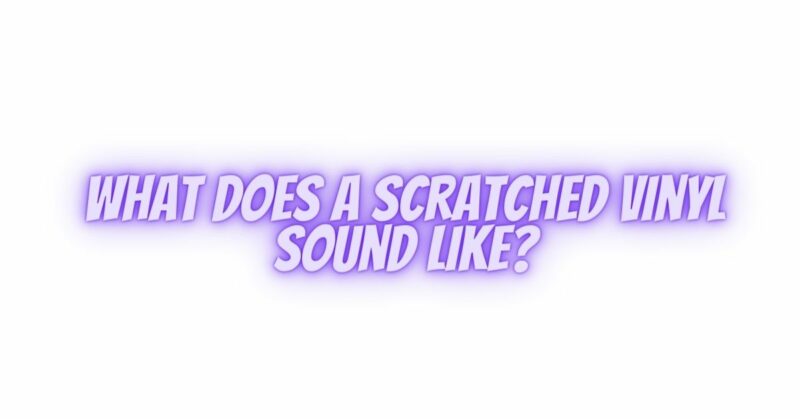Vinyl records are cherished for their warm, analog sound, but they are also susceptible to damage, including scratches. A scratched vinyl can significantly affect the quality of audio playback, introducing unwanted noise and distortions. In this comprehensive guide, we’ll explore what a scratched vinyl sounds like, how scratches occur, and what can be done to mitigate the impact of scratches on your beloved records.
Understanding the Anatomy of a Vinyl Record
Before delving into the sounds of scratched vinyl, it’s essential to understand the structure of a vinyl record:
- Grooves: Vinyl records contain grooves that spiral inward from the outer edge to the center. These grooves represent the analog audio signal, with variations in the groove’s depth and width encoding the music.
- Stylus (Needle): A turntable’s stylus, also known as the needle, traces the grooves as the record rotates. The stylus translates the physical grooves into an electrical signal that is then amplified and sent to speakers.
What a Scratched Vinyl Sounds Like
Scratches on a vinyl record can manifest in various ways, depending on their severity and location. Here are common audio symptoms of a scratched vinyl:
- Pops and Clicks:
- The most noticeable and frequent symptom of a scratched vinyl is the occurrence of pops and clicks. These abrupt, sharp sounds occur when the stylus encounters a scratch, causing it to momentarily jump or skip. Pops and clicks can be especially prominent during quiet or silent sections of a track.
- Crackling and Surface Noise:
- Scratches introduce surface noise in the form of crackling or hissing sounds. This noise is often more prevalent as the stylus traverses the scratched area, affecting the overall listening experience.
- Distortion and Skips:
- Severe scratches can cause distortion in the audio and even lead to skips, where the stylus momentarily jumps out of the groove. These issues disrupt the playback and can make the music difficult to enjoy.
- Repetitive Ticks:
- When a scratch extends across multiple grooves, it can produce a repetitive ticking or ticking-like sound as the stylus encounters it with each revolution.
- Tonal Changes:
- Scratches can introduce tonal changes, altering the balance of frequencies in the music. This can result in a shift in the overall sound character, making it less faithful to the original recording.
- Loss of Clarity and Dynamics:
- Overall, a scratched vinyl can lead to a loss of audio clarity and dynamics. The music may sound muddier, less detailed, and less dynamic due to the interruptions caused by the scratches.
How Scratches Occur
Scratches on vinyl records can occur for various reasons, and prevention is essential to preserving your collection. Here are some common causes of scratches:
- Handling Errors: Mishandling records, such as dropping them or mishandling the stylus during playback, can result in scratches.
- Storage Issues: Storing records improperly, especially without protective inner sleeves or in crowded conditions, can lead to scratches over time.
- Dust and Debris: Dust, dirt, or foreign particles on the record’s surface can cause scratches when the stylus passes over them.
- Poor Cleaning Practices: Incorrect cleaning methods, such as using abrasive brushes or excessive force during cleaning, can inadvertently scratch records.
- Low-Quality Equipment: Low-quality or misaligned turntable components, including the stylus and tonearm, can exacerbate the risk of scratches.
Mitigating the Impact of Scratches
While scratches on vinyl records are difficult to repair completely, here are some steps you can take to mitigate their impact:
- Proper Handling: Handle records with care, always holding them by the edges. Avoid touching the grooves or dragging the stylus across the surface.
- Storage: Store records vertically in a cool, dry, and dust-free environment. Use inner sleeves to protect the record surface.
- Cleaning: Clean records using appropriate methods and materials. Use a soft brush or a record cleaning machine to remove dust and debris.
- High-Quality Equipment: Invest in high-quality turntable components, including a well-aligned stylus and tonearm, to minimize the risk of further damage during playback.
- Playback:
- Avoid playing heavily scratched records with a high-end stylus, as it can exacerbate the damage.
- Consider using a dedicated record cleaning machine to deep-clean your vinyl collection.
- Replacement: If a record is severely scratched and unplayable, consider replacing it with a new or better-condition copy.
In conclusion, a scratched vinyl record can exhibit various audio symptoms, including pops, clicks, distortion, and tonal changes. Prevention and proper handling are essential to protect your vinyl collection. While it’s challenging to repair scratches entirely, taking care of your records and using high-quality equipment can help minimize the risk of further damage and ensure that you can enjoy your vinyl records for years to come.


